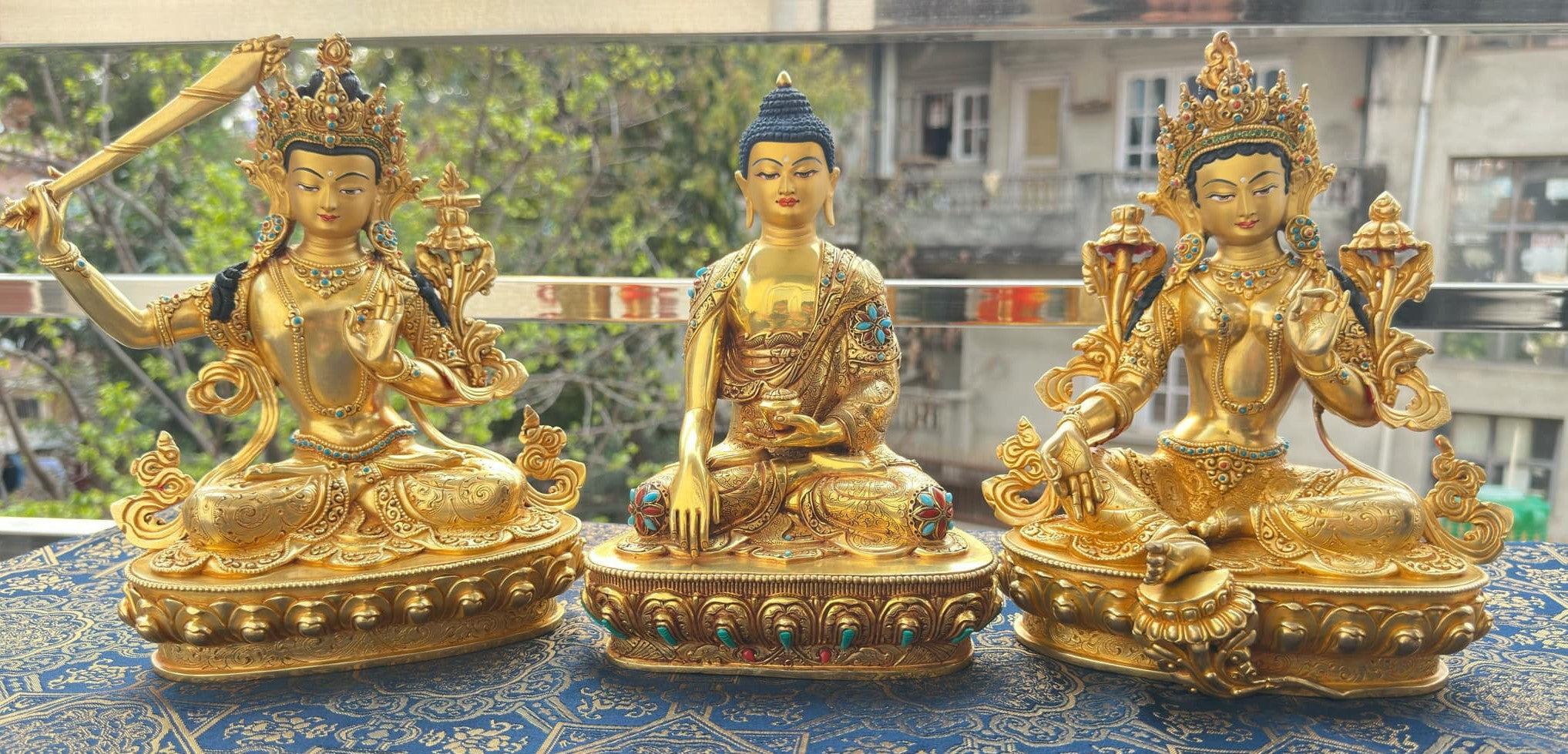Top 5 Vajrayana Buddhist Deities and Their Meanings
Ever wonder who the beautiful, powerful deities in Tibetan art really are? Vajrayana Buddhism is filled with enlightened beings, each embodying a unique quality of compassion, wisdom, purification, protection, or liberation.
In this guide, we’ll introduce you to five of the most widely practiced Vajrayana deities. You'll learn what they represent, their associated mantras, and how to begin connecting with them, whether for meditation, devotion, or sacred art appreciation.
1. Green Tara – The Swift Liberator
Green Tara is the beloved goddess of active compassion. She swiftly responds to the suffering of beings, helping overcome fear, obstacles, and emotional distress.
-
Sanskrit Name: Syamatara
-
Symbolism: Compassion in action, fearlessness, quick protection
-
Mantra: Om Tare Tuttare Ture Soha
She is often depicted seated with one leg extended, ready to leap into action. Green Tara is especially invoked for healing, protection, and guidance through emotional or spiritual challenges.
View our Green Tara Collection here
2. Vajrasattva – The Purifier
Vajrasattva embodies purity and transformation. He is the key deity in purification practices, helping remove negative karma, guilt, and mental obscurations.
-
Sanskrit Name: Vajrasattva
-
Symbolism: Purification of body, speech, and mind
-
Mantra: Om Vajrasattva Hum
He holds a vajra (symbol of indestructible wisdom) and a bell (symbol of emptiness). Practitioners often visualize radiant white light flowing from him while chanting his mantra.
View our Vajrasattva Collection here
3. Avalokiteshvara (Chenrezig) – The Bodhisattva of Compassion
Avalokiteshvara is the embodiment of infinite compassion. He vowed to liberate all beings from suffering and is one of the most universally loved deities in Tibetan Buddhism. The Dalai Lama is considered his human manifestation.
-
Sanskrit Name: Avalokiteshvara
-
Symbolism: Infinite compassion in action through many arms and eyes
-
Mantra: Om Mani Padme Hum
This mantra is recited daily by millions across the Himalayan regions. Avalokiteshvara is often shown with four or a thousand arms, symbolizing his boundless reach and loving activity.
View our Chenrezig Collections here
4. Manjushri – The Wisdom Bodhisattva
Manjushri cuts through ignorance with his flaming sword of wisdom. He represents clarity, eloquence, and sharp insight qualities, especially valuable to students, scholars, and spiritual seekers.
-
Sanskrit Name: Manjushri
-
Symbolism: Wisdom, intellectual clarity, eloquence
-
Mantra: Om Ah Ra Pa Tsa Na Dhi
He is usually depicted holding a flaming sword and a lotus bearing the Prajnaparamita sutra, symbolizing transcendent knowledge.
Shop our Bodhisattva Manjushri Collection here
5. Padmasambhava (Guru Rinpoche) – The Lotus-Born Master
Padmasambhava, or Guru Rinpoche, is the great tantric master who brought Vajrayana Buddhism to Tibet in the 8th century. He is considered the second Buddha and is deeply revered for his power to dispel obstacles and protect the Dharma.
-
Sanskrit Name: Padmasambhava
-
Symbolism: Spiritual power, protection, transformation
-
Mantra: Om Ah Hum Vajra Guru Padma Siddhi Hum
He is often shown in royal robes with a staff and a gaze of fierce compassion, surrounded by flames and lotuses. His image is central to many Tibetan temples and home altars.
View our Guru Rinpoche Statue Collection here
How to Connect with These Deities
You don’t need initiations or advanced training to start building a relationship with these enlightened beings. Here’s how you can begin:
-
Chant their mantras daily with intention and devotion
-
Offer candles, flowers, or incense in front of their image
-
Keep a deity statue or thangka on your altar or sacred space
-
Reflect on their qualities like compassion, wisdom, purification, and try to embody them in daily life
👉 Need ritual items to begin your practice?
You can find handpicked offerings like Tibetan butter lamps, 7 water offering bowls, Bhumba, and other altar essentials in our Ritual Items Collection.
At Nidhiratna, we offer beautifully crafted, fully gold-gilded deity statues representing these divine forms. Upon request, we also perform consecration services, where sacred mantras and blessed relics are placed inside the statue and ritual blessings are offered by Tibetan Lamas.
📚 Continue Your Journey:
Start with the deity who calls to your heart. Your connection is often karmic and a beautiful first step on the Vajrayana path.





















Share:
What is Vajrayana Buddhism? Simple Beginner’s Guide
The Three Long Life Deities in Tibetan Buddhism: Amitayus, Namgyalma & White Tara